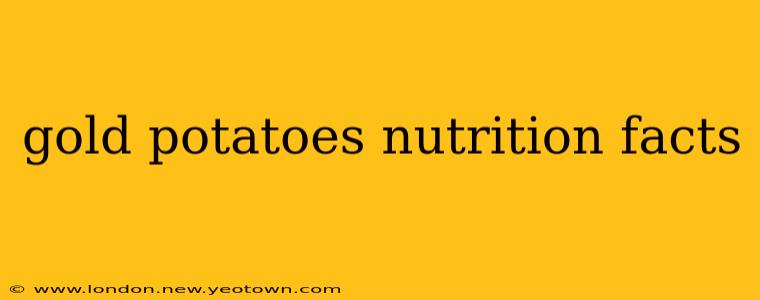The humble potato, a culinary staple across the globe, often gets a bad rap. But did you know that certain varieties, like the striking gold potato, offer a surprising nutritional punch? Forget the bland, starchy stereotype; gold potatoes are bursting with flavor and nutrients, making them a worthy addition to a balanced diet. Let's delve into the delicious details of their nutritional profile and uncover why these golden gems deserve a prominent place on your plate.
What are the nutritional benefits of gold potatoes?
Gold potatoes, characterized by their vibrant yellow flesh, boast a higher concentration of certain vitamins and antioxidants compared to their russet or white counterparts. Think of them as little powerhouses packed with goodness. They're a good source of Vitamin C, an essential antioxidant that protects your cells from damage, boosts your immune system, and aids in collagen production for healthy skin. Their yellow hue hints at a significant amount of beta-carotene, which your body converts into Vitamin A – crucial for vision, immune function, and cell growth.
Beyond vitamins, gold potatoes provide a decent amount of potassium, an electrolyte vital for maintaining healthy blood pressure and muscle function. They also offer dietary fiber, which promotes healthy digestion and helps regulate blood sugar levels. This makes them a surprisingly beneficial choice for those watching their carbohydrate intake. Remember, moderation is key, even with nutritious foods!
How many calories are in a gold potato?
The calorie content of a gold potato varies depending on its size and preparation method. A medium-sized gold potato (roughly 5.3 ounces or 150 grams) typically contains around 110-120 calories. However, this can increase significantly if you add butter, oil, or cheese during cooking. Roasting or baking is generally healthier than frying, as it avoids the addition of extra fats and calories.
Are gold potatoes healthier than white potatoes?
While both gold and white potatoes offer nutritional value, gold potatoes generally edge out their white counterparts in terms of beta-carotene and Vitamin C content. The higher concentration of these nutrients translates to a richer source of antioxidants and vitamins. However, this doesn't mean white potatoes are nutritionally inferior; they still offer valuable nutrients like potassium and fiber. Ultimately, the "healthier" potato depends on individual dietary needs and preferences. Variety is always a good thing!
What are the best ways to cook gold potatoes?
Gold potatoes are remarkably versatile in the kitchen. Their creamy texture and subtly sweet flavor make them delightful in a wide array of dishes. Here are a few ideas to inspire your culinary creativity:
- Roasted: Roasting brings out their natural sweetness and creates a crispy exterior.
- Mashed: Their creamy texture makes them perfect for fluffy mashed potatoes.
- Boiled: A simple and quick method for adding to salads or soups.
- Baked: Stuffed baked potatoes are a fun and flavorful option.
- Fried (in moderation): While not the healthiest option, occasionally enjoying fried gold potatoes can be a tasty treat.
Are gold potatoes good for weight loss?
Gold potatoes, like any other food, can be part of a healthy weight loss plan when consumed in moderation. Their fiber content helps you feel full and satisfied, potentially reducing overall calorie intake. However, it's crucial to pay attention to portion sizes and cooking methods to avoid adding extra calories through fats and oils. Remember, a balanced diet and regular exercise are crucial for successful weight management.
Do gold potatoes have any potential downsides?
While generally safe and healthy, some individuals might experience digestive discomfort after consuming large quantities of potatoes due to their starch content. Also, be mindful of potential pesticide residues, especially if you are buying conventionally grown potatoes. Opting for organic potatoes whenever possible minimizes this risk.
In conclusion, gold potatoes offer a delicious and nutritious addition to a balanced diet. Their vibrant color is a testament to their rich nutritional content, making them a far cry from the bland potato of popular imagination. So, next time you're at the grocery store, reach for the gold – your body will thank you!

